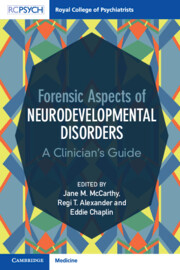Book contents
- Forensic Aspects of Neurodevelopmental Disorders
- Forensic Aspects of Neurodevelopmental Disorders
- Copyright page
- About the Cover Page
- Contents
- Contributors
- Foreword by the Rt Hon Lord Bradley
- Terminology Used in the Book
- Section 1 An Overview: Definitions, Epidemiology and Policy Issues
- Chapter 1 Introduction
- Chapter 2 Aetiology of Neurodevelopmental Disorders
- Chapter 3 Overview of Offenders with Intellectual Disability
- Chapter 4 Overview of Offenders with Attention Deficit Hyperactivity Disorder
- Chapter 5 Overview of Offenders with Autism Spectrum Disorder
- Chapter 6 Associations between Autism Spectrum Disorder and Types of Offences
- Chapter 7 Overview of Young People with Neurodevelopmental Impairments in Contact with the Youth Justice System
- Chapter 8 Overview of Offenders with Fetal Alcohol Spectrum Disorders
- Chapter 9 The Role of Subthreshold Neurodevelopmental Disorder in Offending Behaviour
- Chapter 10 Comorbid Mental Disorders and Neurodevelopmental Conditions
- Section 2 Assessment and Therapeutic Approach
- Section 3 Criminal Justice Pathways and Legal Issues
- Index
- References
Chapter 8 - Overview of Offenders with Fetal Alcohol Spectrum Disorders
from Section 1 - An Overview: Definitions, Epidemiology and Policy Issues
Published online by Cambridge University Press: 18 May 2023
- Forensic Aspects of Neurodevelopmental Disorders
- Forensic Aspects of Neurodevelopmental Disorders
- Copyright page
- About the Cover Page
- Contents
- Contributors
- Foreword by the Rt Hon Lord Bradley
- Terminology Used in the Book
- Section 1 An Overview: Definitions, Epidemiology and Policy Issues
- Chapter 1 Introduction
- Chapter 2 Aetiology of Neurodevelopmental Disorders
- Chapter 3 Overview of Offenders with Intellectual Disability
- Chapter 4 Overview of Offenders with Attention Deficit Hyperactivity Disorder
- Chapter 5 Overview of Offenders with Autism Spectrum Disorder
- Chapter 6 Associations between Autism Spectrum Disorder and Types of Offences
- Chapter 7 Overview of Young People with Neurodevelopmental Impairments in Contact with the Youth Justice System
- Chapter 8 Overview of Offenders with Fetal Alcohol Spectrum Disorders
- Chapter 9 The Role of Subthreshold Neurodevelopmental Disorder in Offending Behaviour
- Chapter 10 Comorbid Mental Disorders and Neurodevelopmental Conditions
- Section 2 Assessment and Therapeutic Approach
- Section 3 Criminal Justice Pathways and Legal Issues
- Index
- References
Summary
This chapter gives an overview of research on offenders with fetal alcohol spectrum disorders (FASDs). We present a history of FASDs and assessment challenges, and describe the diagnostic process. Then we present the epidemiology of FASDs in young offenders: challenges with estimating the prevalence of FASDs; prevalence of FASDs in the criminal justice system; FASD prevalence in young offenders in comparison with other neurodevelopmental disorders; and the patterns, risk and protective factors of justice system encounters in young offenders with FASDs. We then focus on the relationship between FASDs and the criminal justice system in young offenders. We discuss the path to criminal justice encounters and the vulnerabilities of FASD-impacted individuals during investigative interviews. Finally, we discuss the ability to stand trials in young offenders with neurodevelopmental disorders with a focus on FASDs, the roles that evidence of FASDs plays in judicial proceedings, fitness to stand trial, FASD knowledge and awareness among criminal justice system professionals, and give recommendations for questioning individuals with neurodevelopmental disorders during judicial proceedings.
Keywords
- Type
- Chapter
- Information
- Forensic Aspects of Neurodevelopmental DisordersA Clinician's Guide, pp. 84 - 100Publisher: Cambridge University PressPrint publication year: 2023
References
- 3
- Cited by

